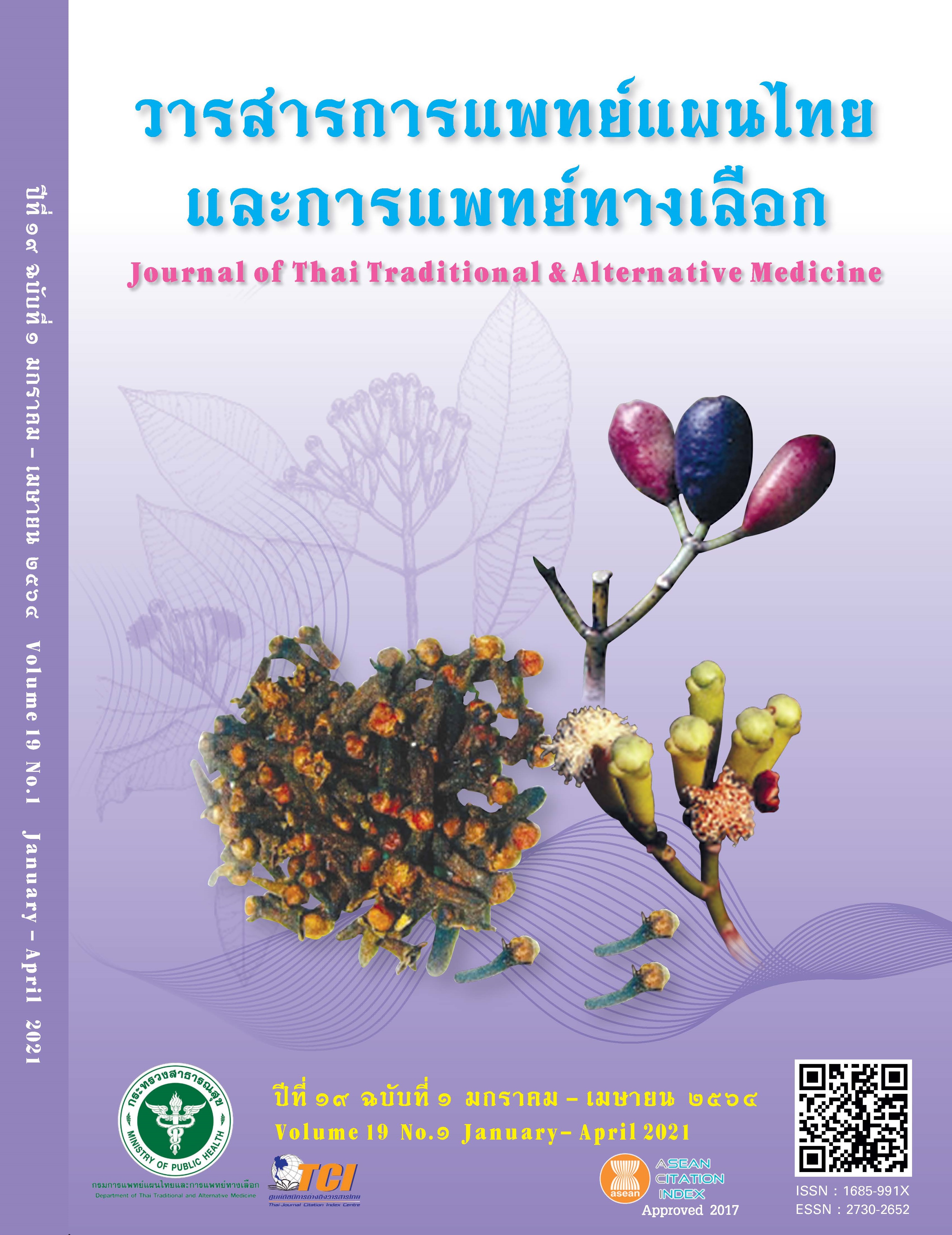Physico-chemical Characteristics of Clove
Main Article Content
Abstract
This study on physico-chemical characteristics of clove (Syzygium aromaticum (L.) Merr. & L.M. Perry)
aimed to obtain data for establishing the quality specification of clove since there had been no standard criteria for this medicinal herb in Thailand. Fifteen samples of clove were collected from August 2016 to March 2017. Chemical identification and physico-chemical properties were studied. The methanolic extract of clove exhibited positive results with Liebermann Burchard test and 1% ferric chloride solution. TLC analysis was performed using silica gel GF254 and a mixture of hexane-acetone (10:1). Spots of eugenol were observed at the Rf value of 0.43. Physico-chemical characteristics exhibited the water and volatile oil contents of 6.06 ± 1.07 and 25.38 ± 3.27% v/w, respectively. The contents of total ash, acid insoluble ash, 95% ethanol extractive and water extractive were 5.70 ± 0.20, 0.05 ± 0.04, 21.17 ± 1.56 and 25.27 ± 0.98%w/w, respectively. Thus, quality specification of clove could be established. The watercontent should not be more than 7%v/w. The contents of totalash and acid in soluble ash should be not more than 7% and 1% w/w, respectively. The contents of 95% ethanol extractive and water extractive should not be less than 19% and 23% w/w. The content of volatile oil should not be less than 23% v/w. Chemical identification using TLC, eugenol must be detected. Furthermore, chemical identification of clove oil by GCMS exhibited eugenol as the main component. The results of this study have led to the establishment of a monograph of Thai Herbal Pharmacopoeia to be used as a reference standard of Thailand.
Article Details
References
Office of Forest Herbarium, Forestand Plant Conservation Research Office, Department of National Parks, Wildlife and Plant Conservation. Tem Smitinand’sThai plant names. 2014 revised edition. Bangkok: National Office of Buddhism Printing House; 2014. (inThai)
Department of Thai Traditional and Alternative Medicine. Monographs of selected Thai materia medica
volume1. Bangkok: Amarin printing and publishing Co.Ltd.; 2009. 324p. (in Thai)
De Oliveira MS, Da Costa WA, Pereira DS, Botelho JRS, De Alencar Menezes TO, De Aquiar Andrade EH, Da Silva SHM, Da Silva Sousa Filho AP, De Carvalho Junior RN. Chemical composition and phytotoxic activity of
clove (Syzygium aromaticum)essential oil obtained with supercritical CO2. J Supercrit Fluids. 2016:18;185-93.
Plata-Rueda A, Campos JM, Da Silva Rolim G, Martínez LC, Dos Santos MH, Fernandes FL, Serrāo JD, Zanuncio JC. Terpenoid constituents of cinnamon and clove essential oils cause toxic effects and behavior repellency response on granary weevil, Sitophilus granaries. Ecotoxicol Environ Saf. 2018:156:263-70.
National List of Essential Medicines B.E. 2562 (2019). Published in Government Gazette, Vol. 124, Part 95D. (2019 April 17). (in Thai)
Pattamadilok D, Sakpetch A, Thana-ariyaroj S, Thiemthieprat P, Chuennangchee V, Jiraputtharom A, Thongsrirak S. Medicinal Plant Research Institute. Final report: Physico-chemical characteristics of clove. Department of Medical Sciences; 2017. (17p). (inThai)
World Health Organization. Quality Control Method for Herbal Materials. Geneva: WHO Press; 2011. 173 p.
Bureau of Drug and Narcotics, Department of Medical Sciences. Thai Herbal Pharmacopoeia 2017. Bangkok: The Agricultural Co-operative Federation of Thailand., Ltd.; 2017. 698p.
British Pharmacopoeia Commission. British Pharmacopoeia 2010. Volume III. London: The Stationary Office; 2009. p. 3547.


